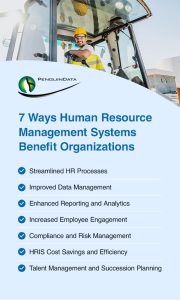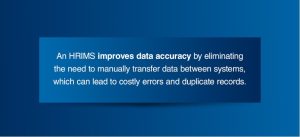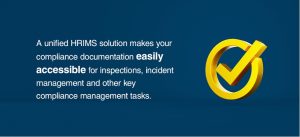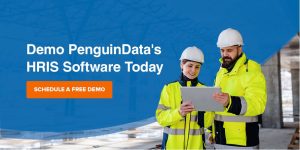A Guide to the Benefits of a Human Resource Information Management System (HRIMS)
While your company may have been able to get away with managing employee data using spreadsheets or other legacy software when it was first starting, today’s digital world demands higher efficiency than manual systems can provide.
Investing in a comprehensive human resource information management system (HRIMS) like PenguinData can help your company boost efficiency, improve the employee experience and increase your overall organizational productivity. Here’s how.
What Is a Human Resource Information Management System?
An HRIMS is a centralized software solution that enables your organization to collect, manage and store employee information for efficient human resources processes and procedures.
Newer solutions often utilize advanced technologies like artificial intelligence (AI), machine learning (ML) and automation to enhance data management and organization tasks for even more streamlined work.
Moving your data to a unified HRIMS solution streamlines workflows and enables more data-driven decision-making in key HR areas such as:
- Payroll
- Benefits administration
- Time tracking and attendance
- Recruiting and hiring
- Managing employee records
- Organizational workflows
While older systems were almost exclusively on-premise — meaning they’re only accessible using your company’s onsite IT infrastructure — today’s HRIMS tools are mostly cloud-based. Hosting your information on cloud servers allows you to reduce IT costs and boost efficiency by expanding access to any internet-connected device in your network.
HRIMS vs. HRMS vs. HCM: What’s the Difference?
Although the different acronyms are interchangeable, they have subtle differences. Here’s a quick explanation of those distinguishing factors:
- HRIS: A human resources information system (HRIS) enables HR professionals to effectively manage employee records, including attendance, benefits, employment contracts and more.
- HRMS: An HRIS is part of a human resource management system (HRMS), which includes employee information management features, talent management and employee engagement capabilities.
- HRIMS: An HRIMS, sometimes also referred to as a human capital management (HCM) solution, is the overarching solution that combines both the HRIS and the HRMS to create a single source of truth for all your employee data and HR processes.
At PenguinData, we offer a fully integrated HRIMS that combines all the benefits of an HRIS and HRMS into one unified solution.
Plus, seamless integration with the other modules in our workforce management suite creates a smooth data flow across your organization. Rather than endlessly switching back and forth between programs, your HR team members can pull the information they need from the centralized data repository on demand for quick insights.
7 Ways Human Resource Management Systems Benefit Organizations

Businesses today across virtually every industry are facing increased pressure to digitize their operations as part of a broader digital transformation. If your organization is working toward digital transformation, an integrated HRIMS like PenguinData can help you achieve your implementation goals.
Here’s our list of the seven essential HRIS benefits you can expect from upgrading your human resources tech stack.
1. Streamlined HR Processes
A better user experience can significantly boost HR efficiency and productivity, which is the most dramatic improvement companies tend to see when adopting an HRIMS solution.
Advanced automation and AI help eliminate some of the unnecessary steps in time-consuming and repetitive HR processes, such as:
- Payroll: Scattered payroll data across disparate manual systems can lead to human error, compliance issues and lost time searching for information. Solutions like the PenguinData HRIMS Payroll Processing Center streamline and automate payroll processing for direct deposits, workers’ comp detail reporting, garnishment services and more.
- Time tracking and attendance: Attendance is a critical element of workforce management, as ensuring the right number of employees are working on any given day is essential for maximizing organizational productivity and profitability. Automated attendance tracking with AI-powered analytics features can help you identify ongoing attendance issues and provide recommendations for resolving them.
- Benefits administration: Consolidating all your employee benefits information into one user-friendly system like the Employee Info Center enables quick access and easy management. The solution also updates in real time so your HR team always has the latest information at their fingertips.
Additionally, workflow automation keeps HR processes moving along without waiting for human workers to take action. So where you would normally encounter a bottleneck waiting for employees to manually launch certain processes, your system can start the ball rolling for you.
2. Improved Data Management
Data consolidation is one of the biggest benefits of a human resource management system, as every HR department manages and maintains a long list of important documents. An HRIMS enables smoother and more effective operations by helping HR teams streamline data and document management.
An integrated HRIMS creates a centralized, cloud-based repository for all your HR documentation, including:
- Job descriptions
- Organization charts
- Employee handbooks
- Employee records
- Policies and procedures
- Compliance documentation
- Department expense sheets
- Onboarding and exit documents
- Training and development resources
- Employment contracts
Keeping this library of documents under one roof simplifies organization for easier access and analysis. Any time your HR team needs to send a new hire their contract or run an expense report, the system can quickly pull the required data from any of its connected solutions.

It also improves data accuracy by eliminating the need to manually transfer data between systems, which can lead to costly errors and duplicate records. Automating data governance tasks cleans these issues up before they can make it into reports for more accurate and effective decision-making.
3. Enhanced Reporting and Analytics
It’s difficult to optimize your HR processes without clear visibility into your workforce and industry. Robust reporting and analytics capabilities enable organizations to uncover the unknowns preventing them from making vital improvements, unlocking the potential for significant gains in efficiency and productivity.
For example, PenguinData’s Reports Focus module offers HR users the ability to generate powerful insights into key areas like:
- Workforce distribution: Work Schedule gives HR users a top-down view of your entire workforce distribution scheme, allowing you to make informed decisions on where and when to increase employee presence in a given area.
- I-9 compliance: Detailed documentation is essential for proving your compliance with evolving labor laws. The I-9 Administration feature helps you ensure your organization is always up to date with I-9 regulations so your organization can avoid noncompliance fees.
- Performance tracking: Hold employees and leadership accountable for their work and identify key areas for improvement with integrated performance tracking and reporting features.
- Worker’s comp: Our solution puts all the data and resources you need at your fingertips so you can efficiently handle claims in line with your organization’s compensation policies and procedures.
Whatever documentation you need to create, our built-in reports writer can generate a visually striking, intuitive report that brings everyone on the same page.
4. Increased Employee Engagement
When your employees are engaged in their work, your company benefits — according to Gallup’s most recent meta analysis on the topic, organizations with the most engaged workforces were 23% more profitable in 2023 than those with high levels of disengagement.
Here’s why. Engaged employees are:
- Team-oriented
- Motivated to do their best work
- Curious and open to learn
- Accountable for their actions
- Optimistic and solution-oriented
On the other hand, disengaged employees are pessimistic, more likely to miss work and unwilling to hold themselves accountable for their performance. Re-engaging these employees can give your organization a significant productivity and profitability boost by giving them a reason to push themselves in their work.
Effective human resources management is critical for improving employee engagement, but time-consuming manual processes can limit your team’s ability to truly connect with the people they manage. After all, engagement is strongest when the human connection is present. Employees need to feel that their employers care about them as people to stay engaged.
Automating these processes with an HRIMS allows your HR team to take a step away from the screen so they can make that connection with your employees.
An Employee Self-Service Center that allows employees to manage their own data is also great for boosting employee engagement. Employees can also make changes to their profiles and connect directly to HR professionals whenever they need help, providing a sense of agency that can help them stay engaged with the company.
5. Compliance and Risk Management
Your HR professionals are responsible for ensuring your organization complies with all federal, state and industry-specific labor laws, including:
- The Americans with Disabilities Act (ADA): This law effectively prohibits employers from discriminating againstpeople with disabilities in hiring decisions, workplace accommodations, sudden termination and more.
- The Equal Pay Act (EPA): Workplaces must pay men and women equal compensation for equal work. For example, a male manager must receive the same salary as a female manager with the same amount of experience and job duties.
- The Fair Labor Standards Act (FLSA): Employers are required to follow their state’s laws surrounding recordkeeping, minimum wage, overtime pay, youth employment and other key concerns.
- The Employee Retirement Income Security Act (ERISA): Employers that provide pension plans must comply with the minimum requirements for plan features and funding, benefits accrual, vesting and more.
- The Occupational Health and Safety Act (OSH): Companies must follow the minimum workplace safety standardsestablished by the Occupational Health and Safety Administration (OSHA) to protect their employees from workplace injuries and other disasters.
Failure to comply with these regulations can cost your organization thousands or even millions in noncompliance penalties. And when incidents happen, thorough documentation is critical for resolving the issue in compliance with these laws.

A unified HRIMS solution makes your compliance documentation easily accessible for inspections, incident management and other key compliance management tasks. Additionally, automated compliance updates help you keep up with frequent changes in regulatory requirements so you can rest assured knowing you have the latest information at your fingertips.
Our development team at PenguinData is constantly updating our solutions to provide the latest information and features for the optimal user experience, and that includes keeping up with regulatory changes. Additionally, advanced reporting and analytics capabilities in the Reports Focus module help you track your I-9 compliance to avoid costly penalties that can harm your bottom line.
6. HRIS Cost Savings and Efficiency
Although implementing an HRIMS is a considerable investment for your organization, this software can help you save money in the long term. An HRIS can cut costs for your organization in a few ways:
- More effective attendance tracking improves labor cost management and improves employee efficiency.
- Process and workflow automation eliminates costly redundancies and errors in your employee data.
- Advanced reporting and analytics capabilities provide valuable insights for more cost-effective decision-making.
- Self-service portals improve employee engagement, reducing the costs associated with high turnover rates.
- Streamlined compliance management and reporting features help you prevent noncompliance penalties from impacting your bottom line.
- Integration with other tools enables seamless workflows and higher productivity.
- A cloud-based service model reduces operational expenses by eliminating the need to develop and maintain an on-premise solution.
The key to maximizing cost savings with your HRIS is a well-planned implementation. In addition to a system that functions properly, effective implementation ensures that your HR team feels confident in learning how to use your new technology for the best results.
Check with the software vendors on your shortlist to find out whether they offer implementation services like user training, ongoing support and automatic updates.
7. Talent Management and Succession Planning
When your employee data is spread across multiple different incompatible systems, talent acquisition and management become significantly more complex. A distributed system makes it difficult to keep track of important information like individual qualifications, skills, experience and more.
Advanced HRIMS and HRMS solutions often come with talent management capabilities that can help you:
- Identify and recruit ideal candidates for open roles.
- Efficiently onboard new hires with intelligent automation.
- Identify qualified employees to take over business-critical roles when the people in those roles step down.
- Provide valuable insights for improving your engagement and retention efforts.
- Monitor employee performance over time to ensure productivity.
- Offboard terminated employees quickly and efficiently while maintaining the required documentation.
For example, you need access to the latest and most accurate employee information for effective succession planning. Because all your employee data is under the unified roof of the HRIMS, you can easily keep tabs on who the best fit is for business-critical roles.
It’s important to note that while a basic HRIS usually doesn’t include talent management features, a more comprehensive solution like an HRMS or an HRIMS typically does. Always check what your software vendor includes with their product before settling on any specific solution so you can ensure you have the tools you need to accomplish your goals.
Demo PenguinData’s HRIS Software Today
If your human resources team needs a process improvement, PenguinData’s advanced HRIS may be the right match for you. When you work with us, you become more than just a customer — you become a valuable member of our Rookery.
Our HRIMS integrates directly into our accounting platform, and bi-directional data flow between systems enables streamlined access, simplified data management and powerful analytics and reporting. Plus, our system is highly scalable to suit your business’s unique requirements — whether you need to invest in a comprehensive solution right away or you prefer to add modules as your needs change, our dynamic system can grow with your company.
Request your free demo today to learn how PenguinData’s advanced HRIS software solution can enhance your HR operations.
LINKS
- https://www.penguindata.com/demo/request-webinar-marketing.aspx
- https://www.gallup.com/workplace/236927/employee-engagement-drives-growth.aspx
- https://www.penguindata.com/hrims/pages/reports.aspx
- https://www.penguindata.com/hrims/pages/Default.aspx
- https://www.penguindata.com/hrims/pages/payroll.aspx
- https://www.penguindata.com/hrims/pages/employee.aspx
- https://www.shrm.org/topics-tools/tools/toolkits/developing-sustaining-employee-engagement
- https://www.dol.gov/general/topic/disability/ada
- https://www.eeoc.gov/statutes/equal-pay-act-1963
- https://www.dol.gov/agencies/whd/flsa
- https://www.dol.gov/general/topic/retirement/erisa
- https://www.osha.gov/laws-regs/oshact/completeoshact
- https://www.forbes.com/sites/forbeshumanresourcescouncil/2024/02/02/20-strategies-for-navigating-effective-succession-planning/?sh=5a9beb583eed
- https://www.penguindata.com/why-penguindata/
- https://www.penguindata.com/about/
- https://www.thehrdigest.com/hr-automation-enhancing-accuracy-and-reducing-bias/


